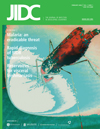Drug susceptibility testing using molecular techniques can enhance tuberculosis diagnosis
DOI:
https://doi.org/10.3855/jidc.320Keywords:
drug resistant phenotype, drug resistant genotype, probe method, time to positivity, smear gradation, rapid diagnosisAbstract
Background: Sputum samples were collected from tuberculosis patients in a high tuberculosis incidence area in the Western Cape, South Africa. The aim of this study was to evaluate the performance and time to diagnosis of a genotypic drug susceptibility testing method. Methodology: During June 2000 and November 2003, a total of 1,540 samples were sent for drug susceptibility testing (DST) to the national health laboratory services, and of those, a phenotypic DST result was obtained for 1,373 samples whereas a genotypic DST result was obtained for 1,301 of 1,540 samples. Performance-based calculations were done on 1,244 samples for which both a phenotypic and genotypic DST result was available. Results: The reproducibility of the genotypic and phenotypic DST methods was 97% and 95%, respectively. The sensitivity and specificity of the genotypic DST method was 68% and 99% for Isoniazid and 87% and 99% for Rifampicin, respectively. Smear gradation was found to influence the performance of the genotypic DST method. The genotypic DST method gave accurate DST results for 75% of the samples within 20 days (range, 15-25), whereas the phenotypic DST results were only available for 75% of the samples after 38 days (range, 26-115) (p<0.001). Conclusion: This study showed that the genotypic DST could improve tuberculosis control by rapid diagnosis of drug resistant tuberculosis. This finding may have important implications for the control of drug resistant tuberculosis as it may reduce the chance for further transmission events.Downloads
Published
2008-02-01
How to Cite
1.
Johnson R, Jordaan AM, Warren R, Bosman M, Young D, Nagy JN, Wain JR, Van Helden PD, Victor TC (2008) Drug susceptibility testing using molecular techniques can enhance tuberculosis diagnosis. J Infect Dev Ctries 2:040–045. doi: 10.3855/jidc.320
Issue
Section
Original Articles
License
Authors who publish with this journal agree to the following terms:
- Authors retain copyright and grant the journal right of first publication with the work simultaneously licensed under a Creative Commons Attribution License that allows others to share the work with an acknowledgement of the work's authorship and initial publication in this journal.
- Authors are able to enter into separate, additional contractual arrangements for the non-exclusive distribution of the journal's published version of the work (e.g., post it to an institutional repository or publish it in a book), with an acknowledgement of its initial publication in this journal.
- Authors are permitted and encouraged to post their work online (e.g., in institutional repositories or on their website) prior to and during the submission process, as it can lead to productive exchanges, as well as earlier and greater citation of published work (See The Effect of Open Access).








